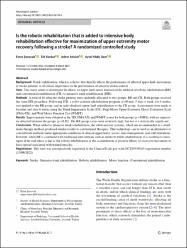| dc.contributor.author | Şenocak, Emre | |
| dc.contributor.author | Korkut, Elif | |
| dc.contributor.author | Aktürk, Adem | |
| dc.contributor.author | Yıldız Özer, Aysel | |
| dc.date.accessioned | 2023-04-04T12:23:30Z | |
| dc.date.available | 2023-04-04T12:23:30Z | |
| dc.date.issued | 2023 | en_US |
| dc.identifier.issn | 1590-1874 | |
| dc.identifier.issn | 1590-3478 | |
| dc.identifier.uri | https://hdl.handle.net/11363/4300 | |
| dc.description.abstract | Background Trunk stabilization, which is a factor that directly afects the performance of afected upper-limb movements
in stroke patients, is of critical importance in the performance of selective motor control.
Aims This study aimed to investigate the efects on upper-limb motor function of the addition of robotic rehabilitation (RR)
and conventional rehabilitation (CR) to intensive trunk rehabilitation (ITR).
Methods A total of 41 subacute stroke patients were randomly allocated to two groups: RR and CR. Both groups received
the same ITR procedure. Following ITR, a robot-assisted rehabilitation program of 60 min, 5 days a week, for 6 weeks,
was applied to the RR group, and an individualized upper-limb rehabilitation to the CR group. Assessments were made at
baseline and after 6 weeks using the Trunk Impairment Scale (TIS), Fugl-Meyer Upper Extremity Motor Evaluation Scale
(FMA-UE), and Wolf Motor Function Test (WMFT).
Results Improvements were obtained in the TIS, FMA-UE, and WMFT scores for both groups (p<0.001), with no superiority detected between the groups (p>0.05). The RR group scores were relatively high, but not to a statistically signifcant.
Conclusions When added to intensive trunk rehabilitation, the robot-assisted systems, which are recommended as a standalone therapy method, produced similar results to conventional therapies. This technology can be used as an alternative to
conventional methods under appropriate conditions of clinical opportunity, access, time management, and staf limitations.
However, when RR is combined with traditional interventions such as intensive trunk rehabilitation, it is essential to investigate if the real efect is due to the robotic rehabilitation or the accumulation of positive efects of excessive movement or
force spread associated with trained muscles.
Registration This trial was retrospectively registered in the ClinicalTrials.gov with NCT05559385 registration number
(25/09/2022). | en_US |
| dc.language.iso | eng | en_US |
| dc.publisher | SPRINGER-VERLAG ITALIA SRLVIA DECEMBRIO, 28, MILAN 20137, ITALY | en_US |
| dc.relation.isversionof | 10.1007/s10072-023-06739-3 | en_US |
| dc.rights | info:eu-repo/semantics/openAccess | en_US |
| dc.rights | Attribution-NonCommercial-NoDerivs 3.0 United States | * |
| dc.rights.uri | http://creativecommons.org/licenses/by-nc-nd/3.0/us/ | * |
| dc.subject | Stroke | en_US |
| dc.subject | Intensive trunk rehabilitation | en_US |
| dc.subject | Robotic rehabilitation | en_US |
| dc.subject | Motor function | en_US |
| dc.subject | Conventional rehabilitation | en_US |
| dc.title | Is the robotic rehabilitation that is added to intensive body rehabilitation effective for maximization of upper extremity motor recovery following a stroke? A randomized controlled study | en_US |
| dc.type | article | en_US |
| dc.relation.ispartof | Neurological Sciences | en_US |
| dc.department | Sağlık Hizmetleri Meslek Yüksekokulu | en_US |
| dc.authorid | http://orcid.org/0000-0003-3677-9813 | en_US |
| dc.authorid | http://orcid.org/0000-0002-4778-3781 | en_US |
| dc.authorid | http://orcid.org/0000-0002-2487-5720 | en_US |
| dc.authorid | http://orcid.org/0000-0003-0739-6143 | en_US |
| dc.identifier.startpage | 1 | en_US |
| dc.identifier.endpage | 9 | en_US |
| dc.relation.publicationcategory | Makale - Uluslararası Hakemli Dergi - Kurum Öğretim Elemanı | en_US |



















